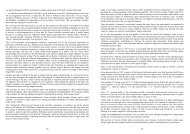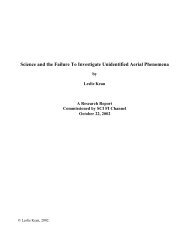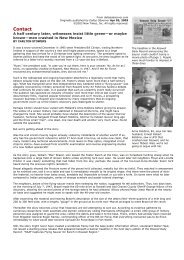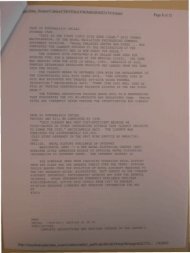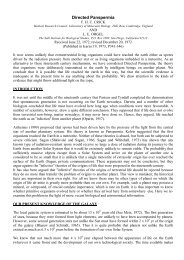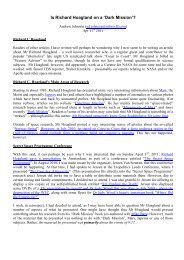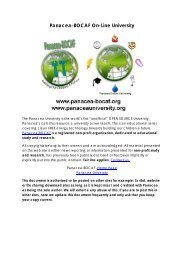Mars Anomalies Print.pdf - CheckTheEvidence.com
Mars Anomalies Print.pdf - CheckTheEvidence.com
Mars Anomalies Print.pdf - CheckTheEvidence.com
- No tags were found...
You also want an ePaper? Increase the reach of your titles
YUMPU automatically turns print PDFs into web optimized ePapers that Google loves.
Background Image Water Ice Frost on <strong>Mars</strong><br />
Viking 2 Lander, P21873, 18 th May 1979 –<br />
Image Reprocessed by<br />
Holger Isenberg<br />
Life on <strong>Mars</strong><br />
Check the Original NASA Data!
Please review these Websites<br />
2<br />
• Please see these Websites for more<br />
information:<br />
• http://marsnews.de/<br />
• http://xenotechresearch.<strong>com</strong>/<br />
• http://mars.spherix.<strong>com</strong>/mars.html<br />
• http://homepage.mac.<strong>com</strong>/alandmoen/<br />
• www.enterprisemission.<strong>com</strong><br />
• http://www.checktheevidence.<strong>com</strong>/<br />
Contact: Andrew Johnson ad.johnson@ntlworld.<strong>com</strong>
What Colour is the Sky on <strong>Mars</strong><br />
3<br />
• Richard Hoagland states that when Viking Landed on<br />
<strong>Mars</strong>, the initial pictures showing a Grey/Bluish sky<br />
(left) were deliberately changed, in the 1 st 2 hours, to<br />
show the reddish colour (right).<br />
• Barry E. DiGregorio and Dr Gilbert V. Levin<br />
corroborate this story in a book called <strong>Mars</strong>: The Living<br />
Planet (ISBN: 1883319587)
Viking Surface Pictures 2<br />
4<br />
• Holger Isenberg has taken original Viking Lander image data and reprocessed<br />
and enhanced it to produce the image below<br />
• http://marsnews.de/color/blue.html
What Colour is the Sky on <strong>Mars</strong><br />
NASA’s<br />
own<br />
version is<br />
on the left.<br />
A reprocessing<br />
of the data<br />
with<br />
properly<br />
adjusted<br />
filters gives<br />
the image<br />
on the<br />
right.<br />
5
6<br />
What Colour is the Sky on <strong>Mars</strong> #1
Viking –Did it Indeed Discover Microbial<br />
Life<br />
7<br />
• Space.<strong>com</strong>, 28 July 2001: Several scientists<br />
have found <strong>com</strong>pelling evidence that Viking<br />
<strong>Mars</strong> landers did indeed discover life on the<br />
red planet in 1976. A reexamination of<br />
findings relayed to Earth by the probes some<br />
25 years ago, claim the experts, show the telltale<br />
signs of microbes lurking within the<br />
Martian soil… The inventor of the Labelled<br />
Release experiment, Gilbert Levin said "The<br />
Viking LR experiment detected living<br />
microorganisms in the soil of <strong>Mars</strong>," He<br />
added that after years of tests, and over two<br />
dozen nonbiological explanations later,<br />
"none of the many attempts to establish the<br />
oxidant's mimicry of the LR data did so."<br />
Gilbert Levin
Trees<br />
• Found near the Polar Region MGS image<br />
m0804688a.<br />
• Arthur C. Clarke (acclaimed Author) has<br />
stated his beliefs about the discoveries on<br />
<strong>Mars</strong>. On 06 June 2001, he said: "I'm<br />
quite serious when I say have a really<br />
good look at these new <strong>Mars</strong> images,“<br />
Clarke said. "Something is actually<br />
moving and changing with the seasons<br />
that suggests, at least, vegetation," he<br />
said.<br />
• Conversely, James Rice, a planetary<br />
geologist at Arizona State University said:<br />
"Most of the images in question that I<br />
looked over are of dunes in the polar<br />
regions. They are beginning to defrost as<br />
winter draws to a close. The sand<br />
<strong>com</strong>posing the dunes is dark and frost is<br />
bright, thereby causing the spotted pattern<br />
as the dune defrosts. This is not<br />
vegetation but rather the natural<br />
defrosting of dunes and sand sheets."<br />
1.4 km or<br />
0.9 miles<br />
8
“Inca City” 1<br />
9<br />
• From the MSSS Web site:<br />
• Mariner 9 image DAS 8044333<br />
• “‘Inca City’is the informal name<br />
given by Mariner 9 scientists in<br />
1972 to a set of intersecting,<br />
rectilinear ridges that are located<br />
among the layered materials of the<br />
south polar region of <strong>Mars</strong>. Their<br />
origin has never been understood;<br />
most investigators thought they<br />
might be sand dunes, either<br />
modern dunes or, more likely,<br />
dunes that were buried, hardened,<br />
then exhumed.”
MGS Image of “The Face”<br />
10<br />
• MGS has<br />
photographed the face<br />
again on several<br />
occasions, one of the<br />
later images being<br />
shown here.<br />
• NASA generally take<br />
the view that these<br />
new images indicate<br />
the face is more likely<br />
to be a natural feature.<br />
However, simply look<br />
at the Curved top,<br />
relatively straight<br />
sides and curved<br />
bottom!<br />
Face in May 2001 MOC image E0300824
Cydonia and… Avebury (UK)<br />
11<br />
• David Percy notes the significant correspondence between<br />
Spiral Mound/Silbury Hill and the Cydonia crater/Avebury<br />
Circle –see http://www.aulis.<strong>com</strong>/mars.htm. Other features<br />
also show unexplained correspondence.
“T”Structure<br />
12<br />
• MGS Image<br />
SP243004 (South<br />
east of Olympus<br />
Mons)<br />
• Natural channels<br />
rarely end in a<br />
perpendicular 'T'<br />
shape for obvious<br />
reasons.<br />
• I could find no other<br />
references to this<br />
image which<br />
attempted to<br />
explain its origin.
Glass Tubes<br />
• MGS Image M0400291<br />
13<br />
• To me, these look like regular –probably artificial structures.<br />
• “Realists”say there are Sand Dunes or piled up rocks.
“Golf Ball”Dome<br />
14<br />
• This is from MGS Image<br />
m1501228. This looks to me<br />
like some halfburied domed<br />
structure, with ribbing<br />
showing through.<br />
• I could find no NASA (or<br />
other “qualified”explanation<br />
for this structure) –only<br />
questions.<br />
• Perhaps it is even a<br />
Geodesic Dome:
2008 MRO “HiRise”Images of Dome <br />
(PSP_007230_2170)<br />
15<br />
• 10 Feb 2008 http://hirise.lpl.arizona.edu/PSP_007230_2170
“Caterpillar”<br />
16<br />
• 3.3 km (2 miles) below the<br />
“Golf Ball”is this structure<br />
(on image strip<br />
m1501228)<br />
• I couldn’t find any<br />
explanation from NASA<br />
about this image.<br />
• This page:<br />
http://palermoproject.<strong>com</strong>/<br />
lowell2004/grandcentral.ht<br />
m has an analysis of this<br />
image, and states that the<br />
MOLA data for this image<br />
is under “Peer Review”<br />
and therefore not<br />
accessible.<br />
• More on the USGS Web<br />
Site if you want to check it<br />
yourself!<br />
2.1 km or 1.3<br />
miles
2008 MRO “HiRise”Images of<br />
17<br />
“Caterpillar” (PSP_007230_2170)<br />
• 10 Feb 2008 http://hirise.lpl.arizona.edu/PSP_007230_2170
Gusev Crater<br />
• A <strong>com</strong>parison between the publicly accessible <strong>Mars</strong> Express Images and<br />
those from MGS.<br />
• This is where the Spirit Rover has landed.<br />
• These images seem to support the claim that either NASA images have<br />
been filtered and/or camera equipment designed deliberately to be<br />
insensitive to the detection of Chlorophyll (the <strong>com</strong>pound responsible for<br />
photosynthesis in plants).<br />
18<br />
<strong>Mars</strong> Express Image<br />
<strong>Mars</strong> Global Surveyor Image
Squared off Blocks<br />
19<br />
http://marsrovers.jpl.nasa.gov/gallery/all/2/n/581/2N177950967EFFADNDP0645R0M1BR.JPG
20<br />
Another Oddity Just Lying Around..<br />
• Hmmmm, I<br />
wonder why this<br />
“random rock<br />
formation”lies<br />
like this… .<br />
http://marsrover.nasa.gov/gallery/all/2/p/513/2P171912249EFFAAL4P2425R1M1.JPG
More Strange Objects…<br />
21<br />
A NICE<br />
PANORAMA<br />
BUT … WHAT’S<br />
THIS… <br />
•http://photojournal.jpl.nasa.gov/catalog/PIA05984
MUD ON MARS!<br />
22<br />
How can these ridges form<br />
in dry, dusty Sand<br />
•http://news.bbc.co.uk/1/hi/sci/tech/3387903.stm<br />
Scientists are intrigued by the marks Spirit's<br />
airbags left on the surface. The soil shows an<br />
unusual cohesiveness, almost as if the soil grains<br />
were stuck together like mud.<br />
Steve Squyres is also puzzled: "The way in which<br />
the surface has responded is bizarre. It looks like<br />
mud, but it can't be mud.
Why isn’t t NASA talking about the<br />
Fossils on <strong>Mars</strong><br />
23<br />
http://www.xenotechresearch.<strong>com</strong>/marsk.htm
Why isn’t t NASA talking about the<br />
Fossils on <strong>Mars</strong><br />
24<br />
http://xenotechresearch.<strong>com</strong>/spicrin1.htm<br />
http://www.xenotechresearch.<strong>com</strong>/mk443a.htm



